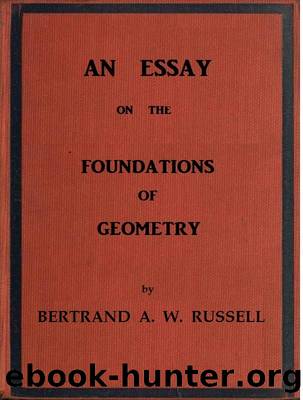An essay on the foundations of geometry by Bertrand Russell

Author:Bertrand Russell [Russell, Bertrand]
Language: eng
Format: epub
Tags: Geometry -- Foundations
Published: 2016-05-17T00:00:00+00:00
Lotze's argument is as follows. In this discussion, though our terminology is necessarily taken from space, we are really concerned with a much more general conception. We assume, in order to preserve the homogeneity of dimensions, that the difference (distance) between any two elements (points) of our manifoldâto borrow Riemann's wordâis of the same kind as, and commensurable with, the difference between any other two elements. Let us take a series of elements at successive distances x such that the distance between any two is the sum of the distances between intermediate elements. Such a series corresponds to a straight line, which is taken as the x-axis. Then a series OY is called perpendicular to the x-axis OX, when the distances of any element y, on OY, from +mx and -mx are equal. By our hypothesis, these distances are comparable with, and qualitatively similar to, x and y. So long as OY is defined only by relation to OX, it is conceptually unique. But now let us suppose the same relation as that between OX and OY, to be possible between OY and a new series OZ; we then get a third series OZ perpendicular to OY, and again conceptually unique, so long as it is defined by relation to OY alone. We might proceed, in the same way, to a fourth line OU perpendicular to OZ. But it is necessary, for our purposes, that OZ should be perpendicular to OX as well as OY. Without this condition, OZ might extend into another world, and have no corresponding relation to OXâthis is a possibility only excluded by our unavoidable spatial images. At this point comes the crux of the argument. That OZ, says Lotze, which, besides being perpendicular to OY, is also perpendicular to OX, must be among the series of OY's, for these were defined only by perpendicularity to OX. Hence, he concludes, there can only be even a third dimension if OZ coincides with one, andâas soon as OX is considered fixedâwith only one, of the many members of the OY series.
In this argument it is difficultâto me at any rateâto see any force at all. The only way I can account for it is, to suppose that Lotze has neglected the possibility of any but single infinities. On this interpretation, the argument might be stated thus: There is an infinite series of continuously varying OY's; to the common property of these, we add another property, which will divide their total number by infinity. The remaining OZ, therefore, must be uniquely determined. The same form of argument, however, would prove that two surfaces can only cut one another in a single point, and numberless other absurdities. The fact is, that infinities may be of different orders. For example, the number of points in a line may be taken as a single infinity, and so may the number of lines in a plane through any point; hence, by multiplication, the number of points in a plane is a double
Download
This site does not store any files on its server. We only index and link to content provided by other sites. Please contact the content providers to delete copyright contents if any and email us, we'll remove relevant links or contents immediately.
Navigation and Map Reading by K Andrew(5111)
Spare by Prince Harry The Duke of Sussex(5072)
Tuesdays with Morrie by Mitch Albom(4693)
Cracking the GRE Premium Edition with 6 Practice Tests, 2015 (Graduate School Test Preparation) by Princeton Review(4224)
Machine Learning at Scale with H2O by Gregory Keys | David Whiting(4183)
Never by Ken Follett(3793)
Goodbye Paradise(3728)
What It Really Takes to Get Into Ivy League and Other Highly Selective Colleges by Hughes Chuck(3696)
Harry Potter and the Prisoner of Azkaban (Book 3) by J. K. Rowling(3304)
Fairy Tale by Stephen King(3220)
Pledged by Alexandra Robbins(3133)
Kick Ass in College: Highest Rated "How to Study in College" Book | 77 Ninja Study Skills Tips and Career Strategies | Motivational for College Students: A Guerrilla Guide to College Success by Fox Gunnar(3076)
A Dictionary of Sociology by Unknown(3031)
Sapiens and Homo Deus by Yuval Noah Harari(2987)
Reminders of Him: A Novel by Colleen Hoover(2952)
The Social Psychology of Inequality by Unknown(2940)
Graduate Admissions Essays, Fourth Edition: Write Your Way into the Graduate School of Your Choice (Graduate Admissions Essays: Write Your Way Into the) by Asher Donald(2876)
Will by Will Smith(2793)
Zero to Make by David Lang(2726)
